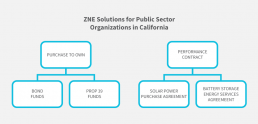
Zero Net Energy (ZNE) is generating a lot of buzz around California, especially for schools and municipalities. So what is Zero Net Energy and does it make sense for your organization to pursue for existing or new buildings?
At the building level, ZNE (also known as “grid neutral”) means a building generates as much energy as it consumes on an annual basis. For schools and other public sector organizations, it is important to note that Zero Net Energy can be defined at a portfolio, campus, or community level. The definition is the same except energy consumption and renewable energy production are aggregated across all relevant sites.
Goals for Zero Net Energy in California
California is leading the charge in ZNE due to effective goal-setting and utility programs to encourage the use of on-site renewable energy and energy efficiency measures. However, ZNE buildings are still not the norm. The New Building Institute (NBI) reported 192 ZNE emerging projects in California and only 22 ZNE verified projects in their 2018 annual report. Of these, schools are a leading category with 62 projects across both categories. The California Long Term Energy Efficiency Strategic Plan for 2009 to 2020 includes a framework for the state to achieve energy efficiency targets for government, private sector, and utility actions. This framework, also known as Title 24, means that ZNE buildings will increase in numbers over the coming years.
In a 2012 update to Title 24, the Strategic Plan outlined the following ZNE goals for California:
- All new residential construction in California will be Zero Net Energy by 2020. (Title 24, Part 6)
- All new commercial construction in California will be Zero Net Energy by 2030. (Title 24, Part 6)
- Heating, Ventilation and Air Conditioning (HVAC) will be transformed to ensure that its energy performance is optimal for California‘s climate.
- All eligible low-income customers will be given the opportunity to participate in the low-income energy efficiency program by 2020.
Within these high level goals, there are several strategies for both new and existing construction that address building codes, lighting, financial tools, incentives, resource labeling, among others. You can read the full report here.
Renewable Energy Credits
To receive credit toward your ZNE goals for renewable energy generation, your organization will need to retain ownership of any Renewable Energy Credits (REC). A Renewable Energy Credit is created for each mega-watt hour (MWh) of renewable energy generation. In certain state markets, RECs are extremely valuable and enable renewable energy to be cost-effective.
In California, RECs have only a nominal monetary value. Retaining ownership of RECs in your solar contract, however, is essential if your organization wants to claim to be “green”. ForeFront Power’s Renewable Energy professionals recognize this point and take steps to ensure that our clients understand the importance of REC ownerships and value monetization.
Building Considerations
At a high level, there are two sides to consider with ZNE: Energy Consumption and Energy Production. Energy consumption should be reduced through energy efficiency measures, such as lighting, insulation, and efficient appliances.
Undoubtedly, on-site clean energy production such as a solar PV system and energy storage will need to be considered. Proposed language for updated Title 24 regulations would also give credit for solar plus energy storage to meet certain energy efficiency requirements. Solar plus energy storage looks like energy efficiency to the electrical grid and can address plug loads. It is also a tool to shift the way customers use energy in a manner that is beneficial to the grid.
When considering building adjustments to meet ZNE regulations, it might help to think of your building as a classic scale, such as the one shown below, with the goal to balance energy consumption on the left with energy production on the right. The best path can begin with energy efficiency improvements to lower the energy consumption side of the scale. Then, on-site clean energy production can be used to balance energy needs with on-site generation.

Financing and Budgeting Upgrades
Energy and facility managers usually have the option to either purchase Zero Net Energy measures or they can enter into a performance contract arrangement with a contractor. On the energy efficiency side, these are referred to as a “Energy Savings Performance Contract”, or ESPC. This innovative financing technique uses cost savings through energy efficiency measures to repay the upfront cost.
On the renewable energy side, this performance contract arrangement is typically called a “Power Purchase Agreement”, or PPA. The PPA allows a customer to engage with a solar or wind developer to build a renewable energy project in return for electricity payments on a kilowatt-hour basis. This transaction is attractive because it does not require any upfront cost on the part of the customer and the kilowatt-hour pricing incorporates a federal investment tax credit from which public agencies would otherwise not be able to benefit.
For public entities in California that still wish to purchase energy efficiency and clean energy measures, the most relevant program is Proposition 39 funding. Also known as the California Clean Energy Jobs Act of 2012, the program includes up to $550 million per year to improve energy efficiency and increase the use of renewable energy.
The figure below summarizes these options for public sector organizations in California.

Solutions for Zero Net Energy
ForeFront Power offers California organizations a variety of products that make ZNE goals achievable. We understand that there is no one-size-fits-all solution, so our team can customize an approach to fit each facility, including the energy solutions shown below.
- On-Site Solar
- Produce Renewable Energy at your facilities
- Retain renewable energy credits
- Save on Energy Expenses starting in Year 1
- Battery Storage
- Control your kW demand profile
- Store Solar Energy to offset ‘off-peak’ power
- Reduce grid energy consumption
- Community Solar
- Receive credit for solar energy at one of our off-site locations
- Retain Environmental Attributes
- Hedge rising energy rates
- Perfect for space constrained sites
Next Steps
Having a ZNE goal may seem daunting for many organizations. That’s why ForeFront Power has a team of energy professionals that are ready to assist you in evaluating on-site and off-site renewable energy options to help you save money and meet your sustainability goals. Our team can evaluate your energy consumption at no cost and make recommendations on what it takes to become a ZNE building, campus, portfolio, or community.
Resources
Zero Energy Resources. Getting to Zero National Forum. This site, includes policy, technical, and educational resources that address the challenges of zero energy construction on a budget. See https://gettingtozeroforum.org/zero-energy-resources/ for more information
Energy Savings Performance Contracting. The Department of Energy has a detailed walkthrough of ESPC as part of its State and Local Solution Center, including a primer specifically for K-12 schools. See https://energy.gov/eere/slsc/energy-savings-performance-contracting for more information.
Grid Neutral: Electrical Independence for California Schools and Community Colleges. This guidebook, updated in 2009, provides an outline for schools to go “grid neutral”. See http://www.documents.dgs.ca.gov/dsa/pubs/gridneutralpub.pdf for more information.

Interested in learning more?
We would love to discuss how our solutions might be a fit for your organization. Contact one of our solar, storage, or e-mobility experts today:







